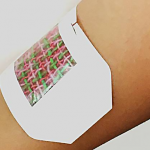 Smart bandage technology is something I’ve touched on a few times. Most of the time, the technology has involved being able to monitor the health of a wound without ‘undressing’ the bandage. Some take on a more active role however, such as administering insulin to manage blood glucose levels.
Smart bandage technology is something I’ve touched on a few times. Most of the time, the technology has involved being able to monitor the health of a wound without ‘undressing’ the bandage. Some take on a more active role however, such as administering insulin to manage blood glucose levels.
A team from the University of Nebraska-Lincoln, Harvard Medical School and MIT believe their smart bandage could eventually heal wounds on its own.
The work, which was documented in a recently published paper, consists of electrically conductive fibers that have been coated in a gel that can itself be loaded with antibiotics, painkillers, tissue-regenerating growth factors or other medications.
Smart treatments
The device contains a microcontroller that’s roughly the size of a postage stamp, which allows the bandage to be managed via a smartphone or other wireless device. This would release a small amount of voltage through the fiber of the bandage, and the heat it produces releases a hydrogel containing the medication.
The team believe that a single bandage could contain several of these microcontrollers, and thus accommodate multiple medications. The smart control allows for very specific control over the dose and delivery of the medications.
“This is the first bandage that is capable of dose-dependent drug release,” the team say. “You can release multiple drugs with different release profiles. That’s a big advantage in comparison with other systems. What we did here was come up with a strategy for building a bandage from the bottom up.”
The team believe that their device will be initially deployed in the treatment of chronic skin wounds resulting from diabetes. It’s believed that over 25 million people could suffer from such wounds in the United States alone.
From that initial application however, the team believe that the versatility of the bandage open it up to many possible use cases. For instance, the fast healing qualities of the bandage could be ideal for military scenarios.
“Soldiers on the battlefield may be suffering from a number of different injuries or infections,” the team explain. “They might be dealing with a number of different pathogens. Imagine that you have a variable patch that has antidotes or drugs targeted toward specific hazards in the environment.”
Put to the test
The researchers pitted their creation against a range of bandages currently on the market. Some of these were simply dry patches, whereas others were more advanced and were capable of releasing medication over time.
In one test, the team applied the smart bandage to a wounded mouse. When compared to regular bandages, the mouse was able to grow approximately three times as much blood-rich tissue, which is key for the healing process.
Similar results emerged in experiments around infection control, with antibiotic-loaded bandages proving extremely effective at eliminating bacteria.
Suffice to say, despite being patented, it still requires a lot more testing on both animals and humans before it’s ready for market, and this alone could delay its availability for several years, but the team hope that the prior approval of many of the device’s components could expedite the process with the FDA.
It’s a fascinating project and further evidence of the growing range of capabilities possible in the modern bandage. Check out the video below to learn more.